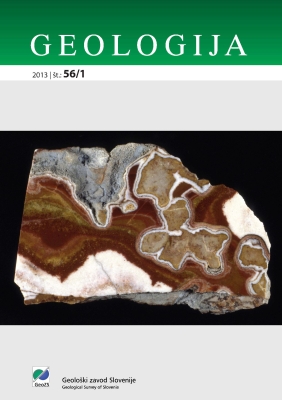Mineral chemistry and genesis of Zr, Th, U, Nb, Pb, P, Ce and F enriched peralkaline granites of El-Sibai shear zone, Central Eastern Desert, Egypt
DOI:
https://doi.org/10.5474/geologija.2013.009Abstract
El-Sibai mineralized shear zone trending NNE-SSW is located at the northern segment of Gabal El-Sibai (500 m in length and 0.5 to 1.5 m in width). Rocks along the shear zone show different types of alterations such as hematization, kaolinitization, fluoritization, and silicification. These alterations are good traps for rare metals of thorite, ferrocolumbite, pyroclore, plumbopyroclore, fluorite, cerite-(Ce), zircon, Th-rich zircon, zirconolite (mixture of zircon & columbite), fluorapatite, titanite, and monazite minerals. The detailed mineralogical study of the El-Sibai shear zone revealed its enrichment in Th, Zr, Nb, Pb, U, F, P, LREE (Ce), especially concerning the hematization processes. The close correlation of ferruginated (hematitized) samples with high radioactivity is related to the high ability of iron oxides for adsorption of radioactive elements from their Solutions. The rare-metal minerals found in altered peralkaline granites (shear zone) are associated with hematitization, albititization, chloritization, fluoritization, and pyritization. Electron probe microanalysis (EPMA) provides an indication of a ränge of solid Solution between thorite and zircon, in which intermediate phases, such as Th-rich zircon were formed. These phases have higher sum of all cations per formula (2.0 to 2.09 atoms per formula unit, for 4 oxygen atoms) than that of ideal thorite and zircon. This is attributed to the presence of substantial amount of interstitial cations such as U, Y, Ca, and AI in these phases. Altered zircon enriched in Th and U (Th-rich zircon) preferentially involves coupled Substitution Ca2+ + (Th,U)4+ ↔ 2Zr4++ 2Si4+, implying that significant amount of U and Th may enter the Zr and Si position in zircon. Thorite and Th-rich zircon are related to hydrothermal fluid. Also the genesis of the studied zircon is related to metasomatic hydrothermal zircon (MHZ). The abundantly detected zircon, Th-rich zircon, Th-bearing minerals and fluorite of demonstrably hydrothermal origin can be attributed to the role of fluorine-rich fluids. Although Zr and Th are generally considered as highly immobile elements, yet the occurrence of zircon indicates that their significant concentrations can be transported under specified F-rich fluids. The hydrothermal origin could be accepted for the thorite, huttonite monazite, zircon, Th-rich zircon, ferrocolumbite, pyroclore, plumbopyrochlore, zirconolite, fluorite, cerite-(Ce), fluorapatite within the El-Sibai altered peralkaline granites (shear zone).Downloads
How to Cite
Ali, M. A. (2013). Mineral chemistry and genesis of Zr, Th, U, Nb, Pb, P, Ce and F enriched peralkaline granites of El-Sibai shear zone, Central Eastern Desert, Egypt. Geologija, 56(1), 107–128. https://doi.org/10.5474/geologija.2013.009
Issue
Section
Articles

